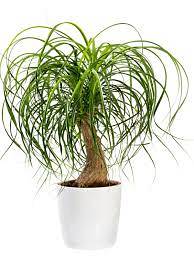Keep soil fairly dry. Water from spring through fall, allowing the top inch or two of soil to dry completely before re-watering. During the winter, only water occasionally. To water, soak the soil and allow the excess water to drain through the bottom of the pot into a dish.
- Why are the tips of my ponytail palm turning brown?
- How do you take care of a ponytail palm?
- Should I cut the dead leaves off my ponytail palm?
- How do you know when a ponytail palm needs water?
- How often do I water my ponytail palm?
- Is coffee grounds good for palm trees?
- Do ponytail palms bloom?
- Do ponytail palms have deep roots?
- Do ponytail palms like to be root bound?
Why are the tips of my ponytail palm turning brown?
My Ponytail Palm has brown tips! This is often a result of over or underwatering. Too much water can cause brown tips with distinct yellowing, while not enough water turns the leaves brown and crispy. Prune the leaves with a clean pair of sheers and check the soil before adjusting watering as needed.
How do you take care of a ponytail palm?
Since this plant is a succulent, it's best to keep it in semi-dry conditions. Let the soil dry out completely in between waterings—perhaps watering once every 2-3 weeks. Water sparingly in the winter months. As with most succulents, your Ponytail Palm will thrive in dry conditions.
Should I cut the dead leaves off my ponytail palm?
Trimming ponytail palms can be done any time of the year but is best during the growing season of spring through early fall. Use clean and sharp bonsai shears to trim leaves on top of the plant. This will force the foliage to grow downward and resemble a ponytail. Remove any damaged leaves that may be brown or wilted.
How do you know when a ponytail palm needs water?
Your Ponytail palm will need its soil to dry well between watering, and if you have any doubt as to whether or not to water the plant, skip it until the next week. If your Pony tail palm develops dry, brown foliage, a shriveled stem or desiccated roots, you can be sure that these are signs of under watering.
How often do I water my ponytail palm?
Allow the top 2 to 3 inches of soil to dry out between waterings and then give the plant a good soak. Indoors, that means you'll probably end up watering your ponytail palm every 3 to 4 weeks.
Is coffee grounds good for palm trees?
Using coffee grounds in the garden on plants can be a possible pest solution for a handsome yet rugged plant like Sago palm trees in the landscape. The Sago Palm (Cycas revoluta) can be used indoors as well. ...
Do ponytail palms bloom?
Flowering on a ponytail palm does not occur the first year you purchase the small plant nor is it likely to during the next decade. Before the plant flowers, it increases significantly in size and girth. The plant's palm-like trunk sometimes grows to 18 feet (5.5 m.) ... Once the plant blooms, it will flower every summer.
Do ponytail palms have deep roots?
The ponytail palm (Beaucarnea recurvata) is an evergreen succulent that looks like a palm tree. Since the length and depth of any tree's roots depends on its height and the spread of its canopy, the size of a ponytail palm's roots depends on whether you grow it outdoors or in a container.
Do ponytail palms like to be root bound?
Potted ponytail palms are happiest when root-bound. If you are trying to grow it as a bonsai, repotting may not be a good idea since ponytail palm replanting encourages the plant to grow bigger.
 Planetagarden
Planetagarden



